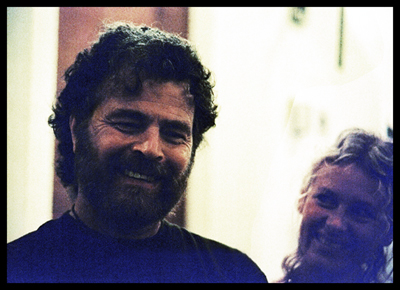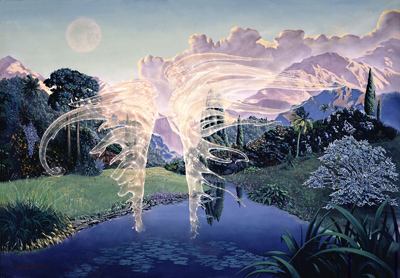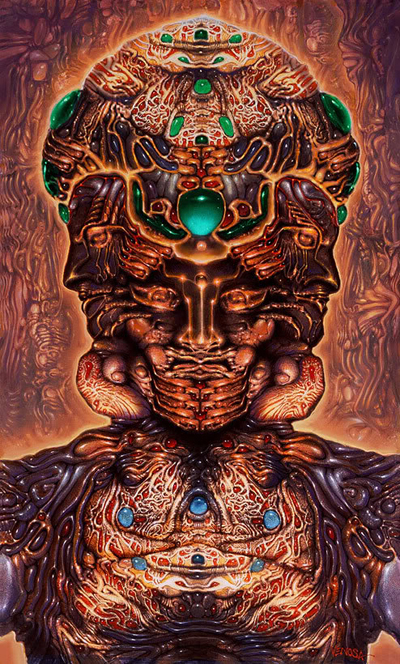Remembering The Fantastic:
Robert Venosa
(January 21, 1936 - August 9, 2011)
v1.0 - Aug 27, 2011
Citation: Hanna J. "Remembering The Fantastic: Robert Venosa (January 21, 1936 - August 9, 2011)". Erowid.org. Aug 27 2011. Erowid.org/culture/characters/venosa_robert/venosa_robert_obituary1.shtml

Photo by Jon Hanna, 1999 |

© 1976-1978 by Robert Venosa |

© 1992 by Robert Venosa |

© 1997 by Robert Venosa |

© 2007 by Robert Venosa |
Fast-forward to September 1999, the year when my own daughter was born. I am attending the AllChemical Arts conference in Hawaii, produced by Terence McKenna, Manolo Torres, and Ken Symington. It was at this event that I first met the great Robert Venosa1, although I'd been a fan of his art for years. Indeed, other than Terence McKenna, Alex Grey, and Tom Robbins, Robert was one of the few presenters scheduled to speak at AllChemical Arts whom I'd actually heard of prior to the event (excluding Alice Walker, Mark Pauline, and Jim Jarmusch, all of whom cancelled). Heck, even my conservative in-laws have had a large framed poster from the early Pomegranate series of Robert's work hanging in their home for the last couple of decades.
Born in New York City, Venosa was a contemporary painter of superior technical ability, singular vision, and prolific output. I was excited to meet Robert, whom I found to embody a combination of bold confidence and humble inquisitiveness, wonder, and appreciation. Noticing that I had a video camera, Robert mentioned that he'd never spoken at a conference before, and he asked me if I would be willing to film his talk. I agreed, but unfortunately, the conference organizers nixed the plan out of concern that attendees would be nervous that their images might be captured against their wishes. I was happy to be able to later invite Robert and his wife Martina Hoffmann to participate in a panel of visionary artists at the third Mind States conference that I produced, held in 2003 to celebrating the 60th anniversary of the discovery of the psychoactive effects of LSD. I made sure that their presentations were videotaped.
If one were to focus solely on execution, Robert's paintings displayed old world excellence. Working with two of the all-time greats of psychedelic art--Mati Klarwein and Ernst Fuchs--Venosa learned the Mische technique employed by the early Flemish masters Hubert and Jan van Eyck, and later by German Renaissance painters such as Albrecht Dürer and Matthias Grünwald. This approach to painting combines layers of semi-transparent egg tempera glazes with oil paints, as a means to create sharply detailed and hyper-luminous images. Using this method within the scope of their visionary works, Venosa and his contemporaries referred to their style as Fantastic Realism. Inspiration for the content of his paintings came at times from the inner voyages that Robert took using various entheogens. These influences are clear within the titles of works such as Ayahuasca Dream, Hallucinatory Self-Portrait, and DM Tree, as well by the subjects of a couple of his portraits: Terence McKenna and Albert Hofmann.2
Over the years, Robert's work appeared on several musical album covers. He was also hired as a conceptual designer for the films Dune, Fire in the Sky, and Race for Atlantis. His art has been featured in countless print publications--most recently in CoSM: The Journal of Visionary Culture--"Cosmic Creativity" (Vol. 7),3 where a portion of Terence McKenna's introduction to Robert's book Illuminatus appears alongside other writing from Terence.
The AllChemical Arts conference was just the beginning of Robert's career as a presenter at gatherings geared toward entheogen enthusiasts. He and Martina continued to speak about the inspirational value of psychedelics on their art at Ayahuasca Healing Retreats, Synergenesis, Burning Man, Mystic Garden Party, and similar gatherings.
In addition to their talks, Robert and Martina offered workshops--some short, some several weeks long--where they taught specific approaches to art production, including their own "modified Mische technique", which allowed artists to achieve luminous results similar to those obtained by the old masters, but in less time. This, then, is one of the most profound direct influences that Robert had on a whole new generation. As someone who actively follows the careers and output of visionary artists, I have witnessed the improved technical abilities of numerous individuals after they have attended extended workshops led by Robert and Martina. Which brings me to a personal inspiration, related to how I began this remembrance.
In 2002 I was hired to MC presentations at the Boom Festival's Liminal Village in Portugal, where Robert and Martina would be speaking about their art, and then leading a hands-on workshop the next day. During their workshop, I obtained invaluable insight into an artistic approach that I had not revisited since my childhood. Robert described how the raw energy and visual impact of a drawing is often most earnestly expressed in the original sketch. He conveyed how some of this magic is lost when one reworks the sketch and copies it in order to produce a painting. His point was that one could do away with the pre-planning and post-planning of any given piece of art, and return instead to a more intuitive, loose, and not-over-developed approach. And so, he had us doodle. We were to scribble aimlessly on a pad of paper for a number of minutes. After a while, we were asked to stop and look at what we had scribbled. We were to consider the abstract lines, and envision what more concrete forms we might pull out of them. We were to cloud gaze. I was once again absorbed into my bedroom wall splattered with joint compound. I once again saw the world as I did when I was a kid. And I was amazed. Nothing in my college art-school education had provided me with such an easy-yet-effective tool for regaining the simple joy of creation without having a plan in mind. There was no over-thinking. Spontaneity ruled. Fun ruled. Suddenly, I understood why it was that Robert's own paintings were so mysterious, with all of their hidden gems waiting to be discovered by the perceptive art appreciator. Robert knew that his unconscious could be trusted to pony-up the authentic goods. That trust, combined with his unparalleled technical execution, is what made Robert a master artist.
Over the course of his life, Robert befriended and/or worked with some incredible individuals: Carlos Santana, Miles Davis, H.R. Giger, Jimi Hendrix, Jackie Kennedy, Timothy Leary--as well as many up-and-coming visionary artists: Nemo Boko, Luke Brown, Vibrata Chromodoris, Kris Davidson, Chris Dyer, Eve Ladyapples, Adam Scott Miller, Cynthia Ré Robbins, Amanda Sage, Delvin Solkinson, Carey Thompson, Roman Villagrana, and more others than I can name. But his most important creative partner, with whom he spent three decades of his life, was his beloved and beautiful companion Martina Hoffmann.4 Even more inspiring than her outer looks, Martina is truly gorgeous on the inside.
Sometime around 11:30 pm a few nights back my phone rang. It was Martina. She was hoping to locate a videotape that I'd shot of Robert last year at the Women's Visionary Congress--an event where she and Robert both spoke about their art--in order to use the footage for his memorial at the Boulder Events Center in Colorado on August 21st. We talked for a while. She expressed how sympathetic friends had voiced the commonly accepted platitude about humans ultimately being souls that have an eternal life beyond the material realm. She strongly felt that Robert's spiritual presence remained with her; she knew this to be true. And even so, she said, when you have spent thirty years of your life with someone else, then that person's permanent physical absence is a difficult reality to adjust to.
Everyone dies. We lose parents, friends, perhaps even children. Losing a spouse may be the hardest loss of all. Having not experienced it, I can't say. But considering the loved ones whom I have lost, I can say that it continues to suck not having them around, regardless of how much time passes. Yet along with that pain, all of the joy that these people brought into my life and the lives of others also is retained in our hearts, memories, and actions. They remain with us in the ways that we are like them, in the ways in which we express their personalities in our day-to-day lives. As I was thinking about writing this remembrance of Robert, who stoically and privately battled cancer for the last eight years, I recalled that I was the first person he asked to videotape a talk that he gave at an event, and the last person--along with my filming partners Tania, Bläk, and Maria--to actually do so. My deepest sympathies go out to Martina.
Those who have heard Robert speak may recall the story of how he met the world's most famous artist, Salvador Dali. In 1972, Robert was in Cadaqués, Spain--Dali's hometown--and he thought to look up the enigmatic Surrealist in the local phone book. Dali's number was listed. Taking the plunge, Robert made the call. Dali answered. After Robert's short introduction about who he was and why he was phoning, Dali melodramatically asked him: "Well... are you beautiful?" Without hesitation, Robert answered affirmatively: "Yes, I'm beautiful." Responding to this reply, Dali immediately invited Robert to a cocktail party by his pool that very evening. It was the start of an important friendship for them both.
I feel privileged to know, as many others who met him also know, that Salvador Dali was not the only one to discover that Robert Venosa was beautiful.
Those called to celebrate Robert's memory and help continue his work may wish to contribute to The Robert Venosa Foundation. Checks should be made payable to: Wells Fargo Advisors, Att: Laura Hay, 1155 Canyon Blvd. #200, Boulder, CO 80302.
- To see more of Robert Venosa's art, visit www.venosa.com.
- Some of Robert's thoughts about the important contributions made by Albert Hofmann, as well as by Salvador Dali, can be found in his article "A Double Dose of Genius", published in the MAPS Bulletin 16(3): 30-32; www.maps.org/news-letters/v16n3-html/double_dose_robert_venosa_albert_hofmann.html.
- For more on this issue of the CoSM journal, see the CoSM website.
- To see Martina Hoffmann's art, visit www.martinahoffmann.com.


